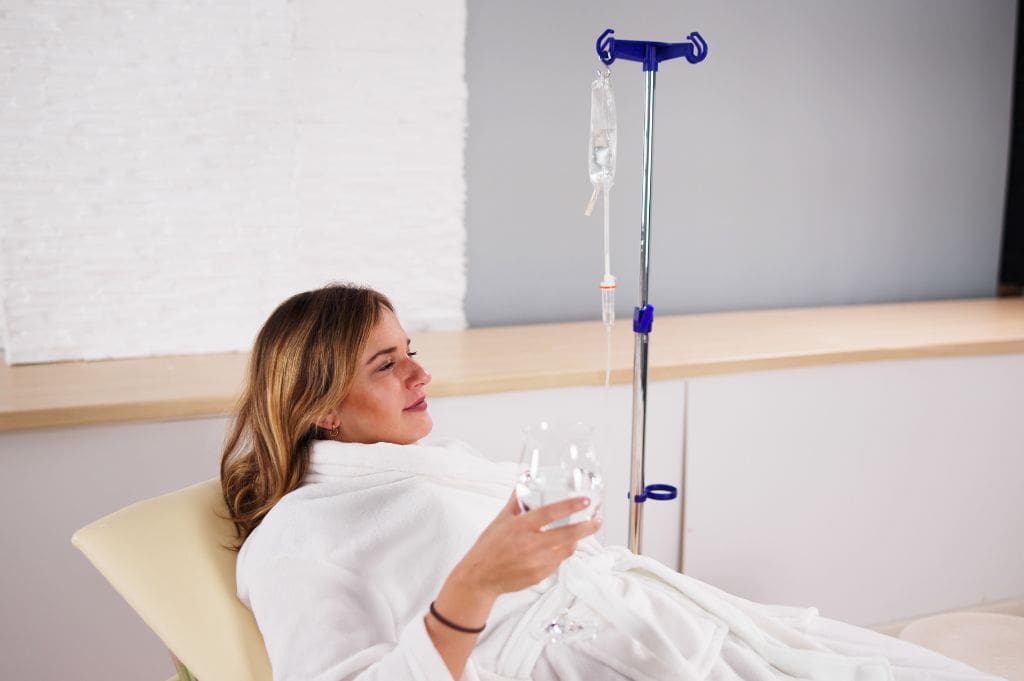
Complications of IV Therapy – QuickDrip IV
When you think of IV therapy, you probably picture a quick and painless way to get essential fluids and nutrients. Although IV therapy is generally safe and helpful, it’s important to be aware of the possible complications of IV therapy that can occur. Some of these complications are easy to spot, like pain at the IV site or bruising. But there are also hidden dangers that you might overlook right away.
In this blog post, we’ll discuss three complications of IV therapy that are often overlooked. Understanding these risks can help you make informed decisions about your healthcare and ensure a safer experience.
1. Infiltration
Infiltration is a common problem during IV therapy. It happens when the IV needle goes through the vein, and the liquid leaks into the nearby area. This can make the IV site swell, hurt, and feel uncomfortable. In bad cases, it can even damage the tissues or cause them to die.
Signs of infiltration include:
- Swelling around the IV site
- Pain or tenderness
- Coolness or blanching of the skin around the IV site
- Resistance to infusion
If you see these signs, you should tell your doctor right away. They can check what’s happening and do something about it, like fixing the IV or stopping the liquid flow.
2. Extravasation
Extravasation is a severe complications of IV fluid therapy that can occur during it. It’s when certain medicines, like chemotherapy or some antibiotics, leak out of the vein and into the nearby tissues. These medicines can damage the tissues, cause blisters, and even cause them to die.
Signs of extravasation include:
- Pain or burning at the IV site
- Swelling
- Redness
- Blistering
- Tissue necrosis
If you have extravasation, it’s important to see a doctor immediately. Getting treated early can help stop the tissues from getting too damaged and lower the risk of long-term problems.
3. Phlebitis
Phlebitis is a complications of IV therapy that causes inflammation of a vein. It’s when the vein gets inflamed. This can happen where the IV is or in a vein that was used for IV therapy before. Phlebitis can hurt, make the vein red, and feel tender. If it’s terrible, it can cause blood clots.
Signs of phlebitis include:
- Pain or tenderness along the vein
- Redness and swelling
- Warmth to the touch
- Hardened vein
If you develop phlebitis, your healthcare provider may recommend removing the IV and applying a warm compress to the affected area. Doctors may also give people medicine called blood thinners to stop blood from sticking together and forming clots.

Complications of IV Therapy – QuickDrip IV
Preventing Complications
While it’s impossible to eliminate all risks associated with IV therapy, there are steps you can take to minimize the likelihood of complications of IV therapy. These include:
- Choosing a reputable healthcare provider: Ensure that a qualified professional with experience in this procedure performs your IV therapy.
- Monitoring the IV site: Regularly check the IV site for signs of redness, swelling, or pain.
- Reporting any concerns: Don’t hesitate to speak up if you experience discomfort or unusual symptoms.
- Following your healthcare provider’s instructions: Adhere to any specific guidelines or recommendations your doctor or nurse gives you.
By taking these steps, you can help ensure a safer and more comfortable IV therapy experience.
FAQs about Complications of IV Therapy
1. What’s the difference between when the IV fluid leaks into the wrong area and when the IV needle goes through the vein?
Both infiltration and extravasation are complications of IV therapy that involve fluid leaking from the vein into the surrounding tissue. However, there is a key difference:
- Infiltration happens when the IV fluid goes into the wrong place around the vein.
- Extravasation occurs when a vesicant drug, such as chemotherapy or certain antibiotics, leaks into the surrounding tissue.
Extravasation can cause more severe tissue damage than infiltration due to the harmful nature of the vesicant drugs.
2. Can phlebitis lead to blood clots?
Yes, phlebitis, a complication of IV therapy involving vein inflammation, can increase the risk of blood clots, especially in the deep veins of the legs.
3. How can I prevent IV-related complications?
There are several steps you can take to help prevent complications of IV therapy:
- Choose a reputable healthcare provider.
- Monitor the IV site regularly for signs of redness, swelling, or pain.
- If you have any worries or problems, tell your doctor right away.
- Follow your healthcare provider’s instructions carefully.
4. What should I do if I suspect a complication?
If you notice any signs of trouble with your IV, such as pain, swelling, or redness around the needle site, it’s important to tell your healthcare provider immediately. Early detection and treatment can help prevent more severe problems.
Don’t wait to report any concerns. Even minor issues can sometimes lead to more significant problems if they must be addressed promptly.
5. Are there any long-term consequences of IV therapy complications?
In some cases, complications of IV therapy can lead to long-term consequences, such as tissue damage or scarring. However, with early diagnosis and treatment, these risks can be minimized. It’s important to discuss your concerns with your doctor and follow their advice.
IV Fluids Complications: Prevention Tips
Understanding IV Therapy Complications
Intravenous (IV) therapy, while a crucial medical procedure, can sometimes lead to complications. These problems can be mild or severe. Here are some tips to help prevent these complications:
Choosing a Trusted Healthcare Provider
- Experience and Expertise: Select a healthcare provider with a proven track record in IV therapy.
- Hygiene and Safety: Ensure the provider maintains high cleanliness and safety standards.
Regular Monitoring of the IV Site
- Watch for Signs: Look for redness, swelling, or pain around the IV site.
- Report Issues Promptly: If you notice any abnormalities, inform your healthcare provider immediately.
Following Healthcare Provider’s Instructions
- Adherence: Strictly follow the guidelines and recommendations provided by your healthcare professional.
- Ask Questions: Don’t hesitate to ask if you have any questions or concerns.
Taking these precautions can significantly reduce the risk of IV therapy complications and ensure a safe and effective treatment experience.
Minimizing Risks of Complications of IV therapy
While IV therapy is usually safe and helpful, it’s important to know about the possible complications of IV Therapy. Understanding and stopping these hidden problems can make your experience safer and more comfortable.
QuickDrip IV Hydration in Allen,TX is committed to providing people with safe and helpful IV treatments. Our experienced professionals work hard to reduce the risk of complications and ensure your comfort and well-being throughout the procedure.
If you have any questions or concerns about IV therapy or want to schedule an appointment, please don’t hesitate to contact us. We’re here to help you make good healthcare choices and get the best hydration possible.
Related Article:
What is in Your Drip? 7 Powerful Ingredients for Total Body Recharge
IV Drip Dilemma: Friend or Foe? Can IV Fluids Cause Diarrhea?

